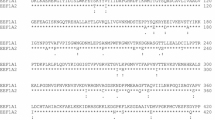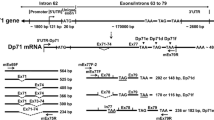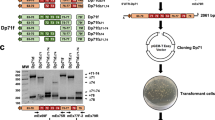Abstract
Dorfin, encoded by the RNF19 gene, is a protein containing two RING finger motifs. Dorfin functions as an E3 ubiquitin ligase that interacts with UBE2L3/UBCH7 and UBE2E2/UBCH8, but not other ubiquitin-conjugating enzymes. Dorfin is found expressed in Lewy bodies, neuronal protein inclusions occurring in Parkinson’s disease brains. This work reports the cloning and analysis of the porcine (Sus scrofa) homologue of dorfin. The RNF19 cDNA encoding dorfin was amplified by reverse transcriptase polymerase chain reaction (RT-PCR) using oligonucleotide primers derived from in silico sequences. The porcine RNF19 cDNA codes for a protein of 838 amino acids which shows a very high similarity to human (97 %) and mouse (93 %) dorfin. The genomic organization of the porcine RNF19 gene is very similar to its human counterpart. Expression analysis by RT-PCR demonstrated that the porcine RNF19 transcript was observed in all organs and tissues examined, although differentially expressed. The highest expression of RNF19 mRNA was observed in cerebellum, heart, frontal cortex and muscle. RNF19 transcript was detected as early as 60 days of gestation in many different brain areas. Radiation hybrid mapping data indicate that the porcine RNF19 gene maps to chromosome 4 (4p11–p12). This particular map location is fully consistent with the currently known conservation of genome organization between human and pig and provides further confirmation that we have characterized the porcine homologue of the human RNF19.



Similar content being viewed by others
Abbreviations
- bp:
-
Base pair
- EST:
-
Expressed sequence tag
- GAPDH:
-
Glyceraldehyde 3-phosphate dehydrogenase
- kb:
-
Kilobases
- ORF:
-
Open reading frame
- PCR:
-
Polymerase chain reaction
- PD:
-
Parkinson’s disease
- pI:
-
Isoelectric point
- RT-PCR:
-
Reverse transcription PCR
- SNP:
-
Single nucleotide polymorphism
- UTR:
-
Untranslated region
References
Lang AE, Lozano AM (1998) Parkinson’s disease, second of two parts. N Engl J Med 339:1130–1143
Farrer MJ (2006) Genetics of Parkinson disease: paradigm shifts and future prospects. Nat Rev Genet 7:306–318
Hishikawa N, Niwa J, Doyu M, Ito T, Ishigaki S, Hashizume Y, Sobue G (2003) Dorfin localizes to the ubiquitylated inclusions in Parkinson’s disease, dementia with Lewy bodies, multiple system atrophy, and amyotrophic lateral sclerosis. Am J Pathol 163:609–619
Ito T, Niwa J, Hishikawa N, Ishigaki S, Doyu M, Sobue G (2003) Dorfin localizes to Lewy bodies and ubiquitylates synphilin-1. J Biol Chem 278:29106–29114
Niwa J, Ishigaki S, Hishikawa N, Yamamoto M, Doyu M, Murata S, Tanaka K, Taniguchi N, Sobue G (2002) Dorfin ubiquitylates mutant SOD1 and prevents mutant SOD1-mediated neurotoxicity. J Biol Chem 277:36793–36798
Niwa J, Ishigaki S, Doyu M, Suzuki T, Tanaka K, Sobue G (2001) A novel centrosomal ring-finger protein, dorfin, mediates ubiquitin ligase activity. Biochem Biophys Res Commun 281:706–713
Morett E, Bork P (1999) A novel transactivation domain in parkin. Trends Biochem Sci 24:229–231
Glickman MH, Ciechanover A (2002) The ubiquitin-proteasome proteolytic pathway: destruction for the sake of construction. Physiol Rev 82:373–428
Schwartz AL, Ciechanover A (2009) Targeting protein for destruction by the ubiquitin system: implications for human pathobiology. Annu Rev Pharmacol Toxicol 49:73–96
Ito E, Toki T, Ishihara H, Ohtani H, Gu L, Yokoyama M, Engel JD, Yamamoto M (1993) Erythroid transcription factor GATA-1 is abundantly transcribed in mouse testis. Nature 362:466–468
Takeuchi H, Niwa J, Hishikawa N, Ishigaki S, Tanaka F, Doyu M, Sobue G (2004) Dorfin prevents cell death by reducing mitochondrial localizing mutant superoxide dismutase 1 in a neuronal cell model of familial amyotrophic lateral sclerosis. J Neurochem 89:64–72
Sone J, Niwa J, Kawai K, Ishigaki S, Yamada S, Adachi H, Katsuno M, Tanaka F, Doyu M, Sobue G (2010) Dorfin ameliorates phenotypes in a transgenic mouse model of amyotrophic lateral sclerosis. J Neurosci Res 88:123–135
Huh JW, Kim DS, Ha HS, Lee JR, Kim YJ, Ahn K, Lee SR, Chang KT, Kim HS (2008) Cooperative exonization of MaLR and AluJo elements contributed an alternative promoter and novel splice variants of RNF19. Gene 424:63–70
Madsen LB, Thomsen B, Larsen K, Bendixen C, Holm IE, Fredholm M, Jørgensen AL, Nielsen AL (2007) Molecular characterization and temporal expression profiling of presenilins in the developing porcine brain. BMC Neurosci 8:72
Yerle M, Echard G, Robic A, Mairal A, Dubut-Fontana C, Raquel J, Pinton P, Milan D, Lahbib-Mansais Y, Gellin J (1996) A somatic cell hybrid panel for pig regional gene mapping characterized by molecular cytogenetics. Cytogenet Cell Genet 73:194–202
Bjerre D, Madsen LB, Bendixen C, Larsen K (2006) Porcine parkin: molecular cloning of PARK2 cDNA, expression analysis, and identification of a splicing variant. Biochem Biophys Res Commun 347:803–813
Freemont PS (2000) RING for destruction? Curr Biol 10:R84–R87
Beasley SA, Hristova VA, Shaw GS (2007) Structure of the parkin inbetween-ring domain provides insights for E3-ligase dysfunction in autosomal recessive Parkinson’s disease. Proc Natl Acad Sci USA 104:3095–3100
Marin I, Ferrus A (2002) Comparative genomics of the RBR family, including the Parkinson’s disease-related gene parkin and the genes of the ariadne subfamily. Mol Biol Evol 19:2039–2050
Capili AD, Edghill EL, Wu K, Borden KLB (2004) Structure of the C-terminal RING finger from a RING-IBR-RING/TRIAD motif reveals a novel zinc-binding domain distinct from a RING. J Mol Biol 340:1117–1129
LaVoie HA (2003) The role of GATA in mammalian reproduction. Exp Biol Med 228:1282–1290
Vingborg RK, Gregersen VR, Zhan B, Panitz F, Høj A, Sørensen KK, Madsen LB, Larsen K, Hornshøj H, Wang X, Bendixen C (2009) A robust linkage map of the porcine autosomes based on gene-associated SNPs. BMC Genomics 27(10):134
Rink A, Santschi EM, Eyer KM, Roelofs B, Hess M, Godfrey M, Karajusuf EK, Yerle M, Milan D, Beattie CW (2002) A first-generation EST RH comparative map of the porcine and human genome. Mamm Genome 13:578–587
Meyers SN, Rogatcheva MB, Larkin DM, Yerle M, Milan D, Hawken RJ, Schook LB, Beever JE (2005) Piggy-BACing the human genome II. A high-resolution, physically anchored, comparative map of the porcine autosomes. Genomics 86:739–752
Acknowledgments
We gratefully acknowledge Dr. Martine Yerle of INRA Toulouse, France for providing the pig-rodent hybrid panel. The authors wish to thank Connie Jakobsen Juhl for excellent technical assistance, and Ms. Janne Hansen for critical reading of the manuscript.
Author information
Authors and Affiliations
Corresponding author
Additional information
The sequence of the porcine RNF19 cDNA, encoding the dorfin protein, and the genomic sequences of RNF19 have been submitted to DDBJ/EMBL/GenBank under the accessions numbers DQ090004, DQ091175, DQ091176, JQ031558 and JQ063125, respectively.
Electronic supplementary material
Below is the link to the electronic supplementary material.
Rights and permissions
About this article
Cite this article
Larsen, K., Madsen, L.B. & Bendixen, C. Porcine dorfin: molecular cloning of the RNF19 gene, sequence comparison, mapping and expression analysis. Mol Biol Rep 39, 10053–10062 (2012). https://doi.org/10.1007/s11033-012-1874-7
Received:
Accepted:
Published:
Issue Date:
DOI: https://doi.org/10.1007/s11033-012-1874-7




